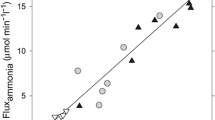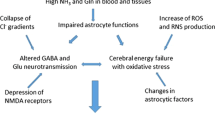Abstract
Using microdialysis, we studied brain extracellular fluid (ECF) amino acid metabolism in rats with experimentally induced hyperammonemia and regional elevation of brain ECF ammonia levels. The total brain ECF amino acid level was increased by an elevation of the blood ammonia level. Hyperammonemia elevated brain ECF aromatic amino acids and reduced arterial blood branched chain amino acids. When rats with hyperammonemia were intravenously administered norleucine, the brain ECF norleucine level rose markedly, suggesting increased permeability of the blood-brain barrier. When rats with hyperammonemia were infused with a branched chain amino acid-rich preparation, the elevated brain ECF aromatic amino acids level was not suppressed. Following local intracerebral ammonia infusion, only glutamate levels showed a marked elevation. These results suggest that impairment of the blood-brain barrier related to hyperammonemia increases the inflow of low molecular weight substances including amino acids. Furthermore, the ammonia-induced increase of glutamate in the cerebral ECF suggests that high ammonia levels may increase the excitability of the brain. Thus, ammonia may serve as a key factor in the onset of hepatic encephalopathy.
Similar content being viewed by others
References
Albrecht, J.(1989). L-glutamate stimulates the efflux of newly taken up glutamine from astroglia but not from synaptosomes of the rat.Neuropharmacology 28:885–887.
Benson, J.R., and Hare, P.E.(1975). O-phthalaldehyde Fluorogenic detection of primary amines in the picomole range. Comparison with fluorescamine and ninhydrin.Proc.Natl.Acad.Sci.USA 72:619–622.
Bloxam, D.L., and Curzon, G.(1978). A study of proposed determinants of brain tryptophan concentration in rats after portacaval anastomosis or sham operation.J.Neurochem. 31: 1255–1263.
Butterworth, R.F., Le, O., Lavoie, J., and Szerb, J.C.(1991). Effect of portacaval anastomosis on electrically stimulated release of glutamate from rat hippocampal slices.J.Neurochem. 56:1481–1484.
Crossley, I.R., Wardle, E.N., and Williams, R.(1983). Biochemical mechanisms of hepatic encephalopathy.Clinical Science 64:247–252.
Fischer, J.E., Rose, H.M., Amin, M.E., James, J.H., Keane, J.M.,and Soeters, P.B.(1976). The effect of normalization of plasma amino acids on hepatic encephalopathy in man.Surgery 80:77–91.
Giguére, J.F., and Butterworth, R.F.(1984). Amino acid changes in regions of the CNS in relation to function in experimental portal-systemic encephalopathy.Neurochem. Res. 9:1309–1321.
Griffin, M., Price, S.J., and Palmer, T.(1982). A rapid and sensitive procedure for the quantitative determination of plasma amino acids.Clin.Chim.Acta. 125:89–95.
Hawkins, R.A., and Jessy, J.(1991). Hyperammonaemia does not impair brain function in the absence of net glutamine synthesis.Biochem.J. 277:697–703.
Hindfelt, B., Plum, F., and Duffy, T.E.(1977). Effect of acute ammonia intoxication on cerebral metabolism in rats with portacaval shunts.J.Clin.Invest. 59:386–396.
Hirayama, C.(1971). Tryptophan metabolism in liver disease.Clin.Chim.Acta 32:191–197.
Hod, G., Chaouat, M., Haskel, Y., Lernau, O.Z., Nissan, S., and Mayer, M.(1982). Ammonia uptake by skeletal muscle in the hyperammonaemic rat.Europ J.Clin.Invest. 12:445–450.
Jessy, J., Mans, A.M., Dejoseph, and Hawkins, R.A.(1990). Hyperammonaenia causes many of the changes found after portacaval shunting.Biochem.J. 272:311–317.
Lockwood, A.H., McDonald, J.M., Reiman, R.E., and Gelbard, A.S. (1979). The dynamics of ammonia metabolism in man. Effect of liver disease and hyperammonemia.J.Clin.Invest. 63:449–460.
Mans, A.M., Biebuyck, J.F., Saunders, S.J., Kirsch, R.E., and Hawkins, R.A.(1979). Tryptophan transport across the blood-brain barrier during acute hepatic failure.J.Neurochem. 33:409–418.
Mans, A.M., Biebuyck, J.F., and Hawkins, R.A.(1983). Ammonia selectively stimulates neutral amino acid transport across blood-brain barrier.Am J Physiol. 245:C74-C77.
Mans, A.M., Biebuyck, J.F., Shelly, K., and Hawkins, R.A.(1982). Regional blood-brain barrier permeability to amino acids after portacaval anastomosis.J.Neurochem. 38:705–717.
Martinez, H.A., Bell, K.P., and Norenberg, M.D.(1977). Glutamine synthetase: glial localization in brain.Science 195:1356–1358.
McDermott, W.V.J.(1957). Metabolism and toxicity of ammonia.New Eng.J.Med. 257:1076–1081.
Oldendorf, W.H.(1971). Brain uptake of radiolabeled amino acids, amines, and hexoses after arterial injection.Am J Physiol. 221:1629–1639.
Sergio, H.E., and Jones, E.A.(1989). Hepatic encephalopathy.Medical Clinics of North America 73, No.4:793–813.
Soeters, P.B., and Fischer, J.E.(1976). Insulin,glucagon, amino acid imbalance and hepatic encephalopathy.Lancet 2:880–882.
Takahashi, H., Koehler, R.C., Brusilow, S.W., and Traystman, R.J.(1990). Glutamine synthetase inhibition prevents cerebral oedema during hyperammonemia.Acta Neurochirurgica Suppl. 51: 346–347.
Tossman, U., and Ungerstedt, U.(1986). Microdialysis in the study of extracellular levels of amino acids in the rat brain.Acta.Physiol.Scand. 128:9–14.
Ungerstedt, U.(1984). Measurement of neurotransmitter release by intracranial dialysis. In Marsden, C.A. (ed.),Measurement of Neurotransmitter Release In Vivo. John Wiley & Son Ltd., Stockholm, Sweden, pp. 81–105.
Young, A.M.J., and Bradford, H.F.(1986). Excitatory amino acid neurotransmitters in the corticostriate path way: studies using intracerebral microdialysisin vivo.J.Neurochem. 47, No.5:1399–1404.
Zieve, L.(1981). The mechanism of hepatic coma.Hepatology 1, No.4:360–365.
Zieve, L., Doizaki, W.M., and Zieve F.J.(1974). Synergism between mercaptans and ammonia or fatty acids in the production of coma: A possible role for mercaptans in the pathogenesis of hepatic coma.J.Lab.Clin.Med. 83:16–28.
Author information
Authors and Affiliations
Rights and permissions
About this article
Cite this article
Suzuki, K., Matsuo, N., Moriguchi, T. et al. Changes in brain ECF amino acids in rats with experimentally induced hyperammonemia. Metabolic Brain Disease 7, 63–75 (1992). https://doi.org/10.1007/BF01000146
Received:
Accepted:
Issue Date:
DOI: https://doi.org/10.1007/BF01000146




